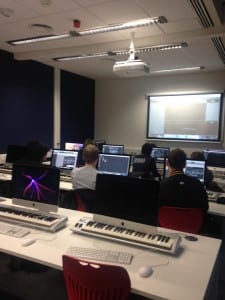Last weekend I participated in my first global game jam! Global game jam is a international initiate, designed to unite game developers for 48 hours to make games around a set theme. This was my first GGJ but not my first game jam generally (I blogged about my first game jam in AP1), and I was excited to get stuck in.
My last jam was a little disappointing, as, despite making some cool sounds and implementing them, they never actually ended up in the final game build (mostly due to the fact the jam was only 24 hours long, and time was extremely precious). I’d enjoyed working with the developer, and had used the time to explore FMOD in greater depth, but this time I decided to take a different approach to the event, by working on my own:
One of the ‘diversifiers’ (a ‘rule’ to include in the game to make it more interesting to develop) was to make the game entirely with audio – no graphical content whatsoever. As i’m passionate about audio, I jumped at the idea of making an audio-only game. My thoughts turned to.. how. The vast majority of game mechanics (the actual gameplay) are related visually, and the challenge of creating simulating gameplay (more than just an interactive audio-book) was hugely exciting to me. I came up with the idea of a 40s/50s noir detective game, investigating a murder. I chose to keep the game jam concept limited, and stuck to simple player interactions, rather than any complex mechanics. I wrote some lines that I recorded my good friend Daniel Berry performing, as well as minor roles from fellow game jammers. I also created ambient background soundscapes for all of the scenes, any foley/object sounds, and my friend Katie Tarrant wrote some awesome 50s ominous jazz tunes for the soundtrack.
Sadly, the game didn’t come together. I spent too much time making the sounds and not enough time thinking about how i’d put them into a ‘game’. I talked about making a audio-only game on twitter over the weekend – and was amazed at the response of a hoard of blind gamers being extremely interested in the idea, and I had a lengthy twitter discussion with Brandon Cole, who is something of an advocate for blind gaming and accessibility to games for the blind community. This was an aspect I hadn’t really considered – that a complex and extensive audio-only game would be perfect for the blind gaming community – and by the sounds of things, something they don’t really have to date.
I won’t talk too much about my idea in depth – as i’m planning on making it as a personal project in the coming months. But I figured i’d do a quick post on my experience of GGJ as a sound designer.
Below is a selection of the VO I recorded for the game sketch. It’s rough, as the recording environment was far from ideal. But an idea of what I got up to.
(LO2, LO4)
